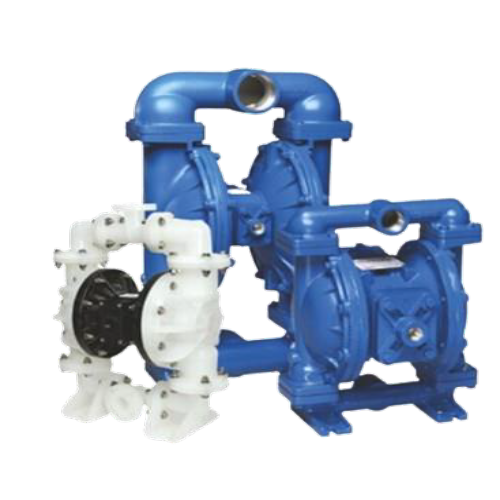AODD Pumps

| Flow Rate | Max 700 Lpm |
|---|---|
| Head | UP |
| Type | VIL |
| Pressure | 8 bar |
| Fluid Temperature | 80 Deg C |
| Stage | Single & Multi |
| Seal type | PP, PVDF, ALU, SS, UHMWPE |
| Material of construction | PP/PFA/PTFE/ PVDF, Aluminium, Stainless steel |
Features & Benefits:
- Deals with liquid containing solid particles.
- Effective for moving highly corrosive fluids.
- Pumps for food transfer applications are offered.
- Simple controls that allow for easy adjustment of the variable flow and head pressure.
- The capacity to run in the dry.
- Up to 6 meters of self-priming AODD pumps.
- There are food-grade pumps available.
- ATEX certificate.
- Used in water transfer applications in factories, process plants, irrigation, and commercial building water distribution systems.
Air Operated Diaphragm Pumps
Introduction Welcome to Flomek, where we specialize in high-quality air operated diaphragm pumps (AODD). In this ultimate guide, we’ll explore everything you need to know about air operated diaphragm pumps, including their functionality, applications, benefits, and maintenance. With over [X years] of experience, Flomek is dedicated to providing reliable pumping solutions that meet diverse industrial needs.
What is an Air Operated Diaphragm Pump? An air operated diaphragm pump is a type of positive displacement pump that utilizes compressed air to transfer fluids. This pump design features two flexible diaphragms that work in tandem to create suction and discharge cycles. As one diaphragm moves down, it draws fluid into the chamber, while the other diaphragm simultaneously pushes the fluid out. This efficient mechanism allows air operated diaphragm pumps to handle a wide range of fluids, including viscous, abrasive, and corrosive materials.
Key Components of Air Operated Diaphragm Pumps
- Diaphragms: The primary components that create the pumping action.
- Air Valve: Controls the direction of air flow, alternating diaphragm movements.
- Pump Body: The robust housing that supports internal components.
- Inlet and Outlet Ports: Allow fluid entry and exit.
- Advantages of Air Operated Diaphragm Pumps offer numerous advantages, making them an ideal choice for various applications:
- Versatility: They can handle a wide variety of fluids, from water to thick slurries.
- Self-Priming: Capable of self-priming, these pumps are perfect for applications with suction lift requirements.
- Dry Running Capability: They can operate dry without sustaining damage, ensuring safe use.
- Adjustable Flow Rates: Users can easily modify flow rates to suit specific needs.
- Applications of Air Operated Diaphragm Pumps find application in numerous industries, including:
- Chemical Processing In the chemical processing industry, air operated diaphragm pumps are used for transferring hazardous and corrosive fluids. Their robust design ensures safety and reliability, minimizing leaks and spills.
- Food and Beverage The food and beverage sector requires hygienic fluid transfers. Flomek’s air operated diaphragm pumps are designed to meet stringent hygiene standards, ensuring contamination-free operations.
- Water and Wastewater Management In water and wastewater management, air operated diaphragm pumps efficiently handle sludge and other challenging materials. Their capability to pump thick and abrasive fluids makes them essential in this field.
- Mining and Mineral Processing Mining operations often involve transferring slurries and heavy materials. Air operated diaphragm pumps provide the necessary strength and reliability to tackle these demanding conditions.
How to Choose the Right Air Operated Diaphragm Pump Selecting the appropriate air operated diaphragm pump requires consideration of several factors: - Fluid Characteristics Assess the properties of the fluid to be pumped, such as viscosity, temperature, and chemical compatibility. Flomek offers a variety of materials to accommodate different fluids.
- Flow Rate Requirements Determine the required flow rate for your application. Flomek provides pumps in various sizes to ensure optimal performance for any flow rate.
- Discharge Pressure Evaluate the discharge pressure needed for your application. Different pumps come with varying pressure ratings, so choose one that fits your specific requirements.
- Installation Environment Consider the environment where the pump will be installed. Ensure it is easily accessible for maintenance and suited for your operational conditions.
Maintenance of Air Operated Diaphragm Pumps Proper maintenance is essential for the longevity and efficiency of your air operated diaphragm pump. Here are key maintenance tips: - Regularly Inspect Diaphragms The diaphragms are critical for pump performance. Regular inspections can help identify wear and tear, allowing for timely replacements.
- Clean Filters Ensure that filters are free from obstructions to maintain optimal flow and performance.
- Monitor Air Supply Regularly check the air supply pressure and quality, as inconsistent air supply can affect pump operation.
- Lubricate Moving Parts Proper lubrication reduces wear and prolongs the lifespan of your pump.
Troubleshooting Common Issues
Even the best air operated diaphragm pumps can experience issues. Here are some common problems and solutions:
Reduced Flow Rate
Causes: Clogged filters or obstructed inlet/outlet ports.
Solutions: Clean filters and check for blockages.
Pulsation in Flow
Causes: Worn diaphragms or improper air supply.
Solutions: Inspect and replace diaphragms as needed; ensure a consistent air supply.
Air Leaks
Causes: Loose fittings or damaged seals.
Solutions: Tighten connections and replace damaged seals.




